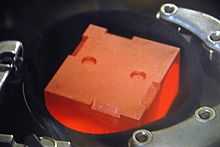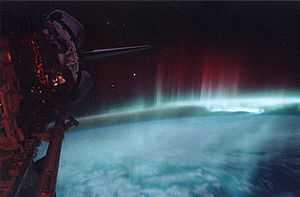Nuclear power in space

Nuclear power in space is the use of nuclear power in outer space, typically either small fission systems or radioactive decay for electricity or heat. Another use is for scientific observation, as in a Mössbauer spectrometer. One common type is a radioisotope thermoelectric generator, which has been used on many space probes and on manned lunar missions, and another is small fission reactors for Earth observation satellites such as the TOPAZ nuclear reactor.[1] A Radioisotope heater unit provides heat from radioactive decay of a material and can potentially produce heat for decades.[2]
Russia has sent about 40 reactors into space and its TOPAZ-II reactor can produce 10 kilowatts.[3] The Romashka reactor family uses uranium and direct thermoelectric conversion to electricity, rather than using a heated fluid to drive a turbine.[4] The United States tested a nuclear reactor in space for 43 days in 1965.[3] While not yet tested in space, the Demonstration Using Flattop Fission (DUFF) on September 13, 2012, was the first test of a nuclear reactor power system for space since then.[5]
Examples of nuclear power for space propulsion systems include nuclear electric rocket (nuclear electric propulsion), radioisotope rocket, and radioisotope electric propulsion (REP).[6] One of the more explored is the nuclear thermal rocket, which was tested in the NERVA program. See also Category:Nuclear spacecraft propulsion (category link).
Benefits

While solar power is much more commonly used, nuclear power offers great advantages in many areas. Solar cells, although efficient, can only supply energy to spacecraft in orbits where the solar flux is sufficiently high, such as low Earth orbit and interplanetary destinations close enough to the Sun. Unlike solar cells, nuclear power systems function independently of sunlight, which is necessary for deep space exploration. Nuclear reactors are especially beneficial in space because of their lower weight-to-capacity ratio than solar cells. Therefore, nuclear power systems take up much less space than solar power systems. Compact spacecraft are easier to orient and direct in space when precision is needed. Estimates of nuclear power, which can power both life support and propulsion systems, suggest that use of these systems can effectively reduce both cost and mission length.[7]
Selected applications and/or technologies for space include
- Radioisotope thermoelectric generator
- Radioisotope heater unit
- Radioisotope piezoelectric generator
- Radioisotope rocket
- Nuclear thermal rocket
- Nuclear pulse propulsion
- Nuclear electric rocket
Types
Radioisotope systems

For more than fifty years, radioisotope thermoelectric generators (RTGs) have been the United States’ main power source in space. RTGs offer many benefits; they are relatively safe and maintenance-free, resilient under harsh conditions, and can operate for decades. RTGs are particularly desirable for use in parts of space where solar power is not a viable power source. Dozens of RTGs have been implemented to power 25 different US spacecrafts, some of which have been operating for more than 20 years. The Stirling Radioisotope Generator (SRG) produces roughly four times the electric power as an RTG, but it has yet to be implemented on an actual mission. NASA plans to utilize two advanced SRGs to explore Titan in the distant future. Radioactive heater units (RHUs) are also used on spacecrafts to warm scientific instruments to the proper temperature so they operate efficiently.
Extremely slow-decaying radioisotopes have been proposed for use on realistic interstellar probes with multi-decade lifetimes.[8]
Fission systems
Fission systems may be utilized to power a spacecraft’s heating or propulsion systems.
In terms of heating requirements, when spacecrafts require more than 100 kWe for power, fission systems are much more cost effective than RTGs. Over the past few decades, several fission reactors have proposed, but these fission systems haven’t been utilized in US space projects as prominently as radioisotope systems have. The Soviet Union, however, launched 31 low power fission reactors utilizing thermoelectric converters between 1967 and 1988. Shortly after, the Soviet Union developed TOPAZ reactors, which utilize thermionic converters instead. In 2008, NASA announced plans to utilize a small fission power system to be used on the surface of the moon and Mars.
Nuclear thermal propulsion systems (NTR) are based on the heating power of a fission reactor, offering a more efficient propulsion system for thrust in launches and landings than one powered by chemical reactions. Current research focuses more on nuclear electric systems as the power source for providing thrust to propel spacecraft that are already in space. Heatpipe Power System (HPS) reactors are very compact, fast fission reactors that can supply power for 10 years to either spacecrafts or vehicles exploring the surface of a planet. Since 1994, HPS reactors have been developed as relatively resilient, safe, and reliable systems. Other space fission reactors used to power space vehicles include the SAFE-400 reactor and the HOMER-15. In 2020, Roscosmos (the Russian Federal Space Agency) plans to launch a spacecraft utilizing nuclear-powered propulsion systems, which includes a small gas-cooled fission reactor with 1 MWe.[9][10]
Micro nuclear reactor
A number of micro nuclear reactor types have been developed or are in development for space applications.
- Jan Leen Kloostermans' U-battery
- RAPID-L
- closed cycle magnetohydrodynamic (CCMHD) power generation system
- SP-100
- Alkali Metal Thermoelectric Converter (AMTEC)
Project Prometheus
In 2002, NASA announced an initiative towards developing nuclear systems, which later came to be known as Project Prometheus. A major part of the Prometheus Project was to develop the Stirling Radioisotope Generator and the Multi-Mission Thermoelectric Generator, both types of RTGs. The project also aimed to produce a safe and long-lasting space fission reactor system for a spacecraft’s power and propulsion, replacing the long-used RTGs. Budget constraints resulted in the effective halting of the project, but Project Prometheus has had success in testing new systems.[11] After its creation, scientists successfully tested a High Power Electric Propulsion (HiPEP) ion engine, which offered substantial advantages in fuel efficiency, thruster lifetime, and thruster efficiency over other power sources.[12]
Visuals
 Red-hot shell containing plutonium undergoing nuclear decay, inside the Mars Science Laboratory MMRTG.[13] MSL was launched in 2011 and has landed on Mars in August 2012. |
 The MSL MMRTG exterior |
 SNAP-10A Space Nuclear Power Plant, shown here in tests on the Earth, launched into orbit in the 1960s. |
Table
| Name and/or model | Fate/Location |
|---|---|
| SNAP-10A | Earth orbit (900+ km altitude) |
| Cosmos 469 BES-5 Buk | |
| Cosmos 516 | High orbited 1972 |
| Cosmos 626 | Earth orbit |
| Cosmos 954 | Earth re-entry 1978 (over Canada) |
| Cosmos 1176 | 11788/11971 Earth orbit 870-970 km |
| Cosmos 1402 | Earth re-entry 1983 (South Atlantic) |
| Cosmos 1607 | High orbited 1985 |
| Cosmos 1670 | High orbited 1985 |
| Cosmos 1677 | High orbited 1985 |
| Cosmos 1682 | High orbited 1986 |
| Cosmos 1736 | High orbited 1986 |
| Cosmos 1771 | High orbited 1986 |
| Cosmos 1818 TEU-5 Topol | Earth orbit[15] |
| Cosmos 1860 | |
| Cosmos 1867 TEU-5 Topol | |
| Cosmos 1900 | High orbited 1987 |
| Cosmos 1932 | Earth orbit 800-900 km |
See also Radioisotope thermoelectric generator#Nuclear power systems in space
See also
- Austere Human Missions to Mars
- Nuclear pulse propulsion
- Nuclear propulsion
- Nuclear thermal rocket
- Nuclear electric rocket
References
- ↑ Hyder, Anthony K.; R. L. Wiley; G. Halpert; S. Sabripour; D. J. Flood (2000). Spacecraft Power Technologies. Imperial College Press. p. 256. ISBN 1-86094-117-6.
- ↑ Radioisotope heater unit "Department of Energy Facts: Radioisotope Heater Units". U.S. Department of Energy, Office of Space and Defense Power Systems. December 1998. Retrieved March 24, 2010.
- ↑ 3.0 3.1 Yury Zaitsev - Nuclear Power in Space (2007) - Spacedaily/RIA Novosti
- ↑ Ponomarev-Stepnoi, N. N.; Kukharkin, N. E.; Usov, V. A. (March 2000). ""Romashka" reactor-converter". Atomic Energy (New York: Springer) 88 (3): 178–183. doi:10.1007/BF02673156. ISSN 1063-4258. Retrieved 2009-01-06.
- ↑ Researchers Test Novel Power System for Space Travel - Joint NASA and DOE team demonstrates simple, robust fission reactor prototype
- ↑ McNutt, et al. - Radioisotope Electric Propulsion (2006) - NASA Glenn Research Center
- ↑ Zaitsev, Yury. "Nuclear Power In Space". Spacedaily. Retrieved 22 November 2013.
- ↑ "Innovative Interstellar Probe". JHU/APL. Retrieved 22 October 2010.
- ↑ Page, Lewis (5 April 2011). "Russia, NASA to hold talks on nuclear-powered spacecraft Muscovites have the balls but not the money". The Register. Retrieved 26 December 2013.
- ↑ "Breakthrough in quest for nuclear-powered spacecraft". Rossiiskaya Gazeta. October 25, 2012. Retrieved 26 December 2013.
- ↑ "Nuclear Reactors for Space". World Nuclear Association. Retrieved 22 November 2013.
- ↑ "NASA Successfully Tests Ion Engine". ScienceDaily. Retrieved 22 November 2013.
- ↑ "Technologies of Broad Benefit: Power". Archived from the original on June 14, 2008. Retrieved 2008-09-20.
- ↑ RORSAT
- ↑ Andrei Kislyakov - Old Russian Nuclear Satellite
External links
- Small Fission Power System Feasibility Study
- Nuclear Power in Space - Office of Nuclear Energy - U.S. Department of Energy(.pdf)
- SAFE-400 paper (fission reactor)
- Design Concept for a Nuclear Reactor-Powered Mars Rover
- David Poston, "Space Nuclear Power: Fission Reactors"
| ||||||||||||
